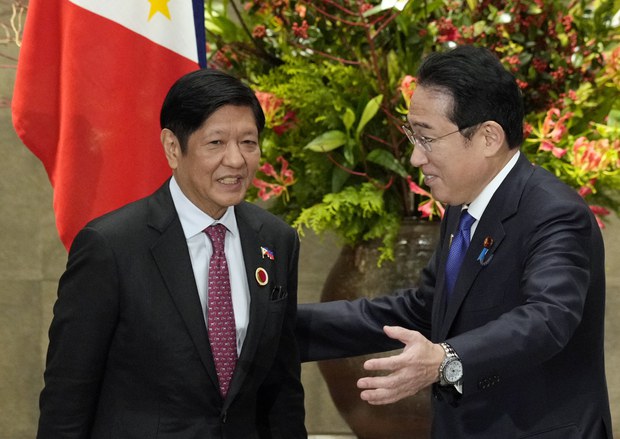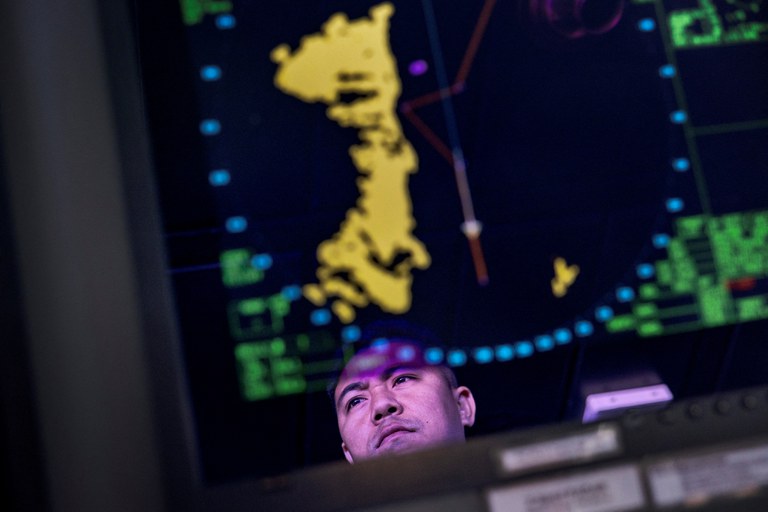Philippines gets Japanese radar system as military training agreement looms
2023.12.20
Manila
 Japanese Prime Minister Fumio Kishida (right) greets Philippine President Ferdinand Marcos Jr. prior to their meeting at the prime minister's official residence in Tokyo, Dec. 17, 2023.
Japanese Prime Minister Fumio Kishida (right) greets Philippine President Ferdinand Marcos Jr. prior to their meeting at the prime minister's official residence in Tokyo, Dec. 17, 2023.
The Philippines inaugurated a Japanese-made radar system on Wednesday that could cover hundreds of miles in boosting national air defenses and helping protect its territorial waters, officials said.
The FPS-3ME Advance Air Surveillance Radar can detect incursions as far away as 300 nautical miles (555 km), including in West Philippine Sea waters where Chinese ships often encroach, Filipino officials said. The West Philippine Sea is Manila’s name for territories and features it claims in the disputed South China Sea.
The inauguration occurred after Philippine President Ferdinand Marcos Jr. and Japanese Prime Minister Fumio Kishida announced in Tokyo over the weekend that both countries were finalizing an agreement to give Japanese troops legal approval to train in the Philippines.
“With over 7,000 islands to guard, the PAF needs the radar system to keep watch of the entire archipelago with greater accuracy and efficiency. This becomes even more crucial given the evolving security landscape in the region,” Lt. Gen. Stephen Parreño, the Philippine Air Force chief, told reporters during the unveiling of the radar system at the Wallace Air Station in San Fernando, a city northwest of Manila.
“The acquisition of this advanced radar system represents a major leap in our capability to protect our sovereign territory and ensure the safety of our citizens,” Parreño said.
Defense Secretary Gilberto Teodoro Jr. received the radar system’s documents from Kenichi Matsuda, Japan’s temporary chargé d’affaires in Manila, during the turnover ceremony.

The system is the first of four, valued together at 5.5 billion pesos (U.S. $98.7 million), which Manila is acquiring from Japan’s Mitsubishi Electric Corp. under the Philippines’ ongoing military modernization program.
Previously, the army had acquired weapons including an Autonomous Truck Mounted Howitzer System armed with 155mm self-propelled guns, multi-launch rocket systems and land-based missile systems, as part of the program to upgrade the nation’s arsenal.
Strategic location
Teodoro said the radar’s range would improve the nation’s defense system.
“We will have a clear picture, not only in the West Philippine Sea but also in other parts of the Philippines’ sea and air domains, (detect) those who are entering our EEZ (exclusive economic zone),” he said.
Wallace Air Station was chosen because of its strategic location, he said.
“This is an exit point of our international airspace and an entry point to Philippine airspace and it is naturally open to the West Philippine Sea and it is unobstructed,” Teodoro said.
Access agreement
The Philippines and Japan, he said, were working to fast-track the Reciprocal Access Agreement between the two countries. The RAA, which is similar to the Visiting Forces Agreement between the Philippines and the United States, will pave the way for larger military exercises between Filipino and Japanese troops. The VFA allows American troops to rotate in and out of the Philippines for training drills and war games.

Marcos and Kishida discussed the reciprocal agreement while on the sidelines of a 50th anniversary commemorative summit between the Association of Southeast Asian Nations (ASEAN) and Japan over the weekend.
“We are in agreement that we considered this to be extremely significant between our two countries. The Reciprocal Access Agreement will give us a greater capability in terms not only of security, but also in terms of disaster preparedness,” Marcos told Kishida, according to transcripts of their meeting.
The agreement, he said, would “bring us greater capacity to maintain peace in the South China Sea.”
Last month, Kishida became the first Japanese leader since World War II to address the Philippine Congress where he pledged Japan’s defense assistance.
“In the South China Sea, trilateral cooperation to protect the freedom of the sea is underway,” Kishida had said, referring to the Philippines, Japan and key military ally the United States.







